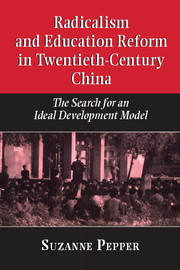Book contents
- Frontmatter
- Contents
- Acknowledgments
- 1 Educational development and the Chinese experience
- Part I The republican era: origins of radical education reform
- Part II Learning from the Soviet Union
- 7 Introducing the Soviet Union
- 8 The Soviet model for Chinese higher education
- 9 Sino-Soviet regularization and school system reform
- 10 Blooming, contending, and criticizing the Soviet model
- Part III Cultural revolution and radical education reform
- Appendix: the Hong Kong interviews
- Select bibliography
- Index
8 - The Soviet model for Chinese higher education
Published online by Cambridge University Press: 04 August 2010
- Frontmatter
- Contents
- Acknowledgments
- 1 Educational development and the Chinese experience
- Part I The republican era: origins of radical education reform
- Part II Learning from the Soviet Union
- 7 Introducing the Soviet Union
- 8 The Soviet model for Chinese higher education
- 9 Sino-Soviet regularization and school system reform
- 10 Blooming, contending, and criticizing the Soviet model
- Part III Cultural revolution and radical education reform
- Appendix: the Hong Kong interviews
- Select bibliography
- Index
Summary
For higher education, the main lessons learned from the Soviet Union revolved around thought reform and structural reorganization. According to the official chronology, reorganization was first proposed in mid-1950; the tertiary sector mobilized its forces to resist; thought reform intervened in 1951–1952; and by 1953, the nation's institutions of higher learning had been reconstructed along Soviet lines. As usual, the actual progression of events was rather more complex than the official chronology suggested.
Although political formulas were still phrased in terms of united front class coalitions, Mao's above-cited declaration in mid-1949 about leaning to one side under the aegis of a people's democratic dictatorship anticipated a renewed revolutionary surge. But the speed and intensity of the shift back from united front to revolutionary politics was also closely tied to a hostile international environment, which in turn complicated education reform.
University reorganization was announced at the First National Higher Education Conference in June 1950. Hostilities in Korea began that same month, and in China, domestic tensions escalated with the search for “counterrevolutionaries,” or active opponents of the new regime. Chinese troops came to the aid of their North Korean ally in October, and in December, the U.S. government halted the remission of all funds to China. The Chinese responded, freezing American assets in China. Financial supply lines for American-funded institutions (see Table 8.1) on the Chinese mainland were cut. All foreign-subsidized and foreign-operated cultural, educational, relief, and religious institutions were required to register. All those receiving American subsidies were nationalized or transferred to private Chinese control.
- Type
- Chapter
- Information
- Radicalism and Education Reform in 20th-Century ChinaThe Search for an Ideal Development Model, pp. 164 - 191Publisher: Cambridge University PressPrint publication year: 1996



